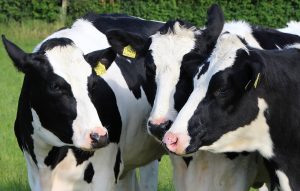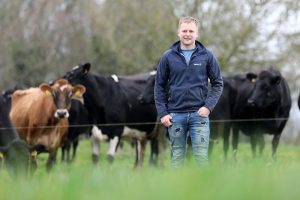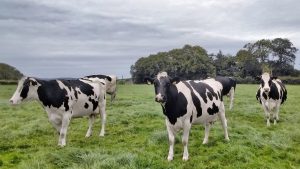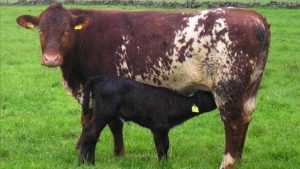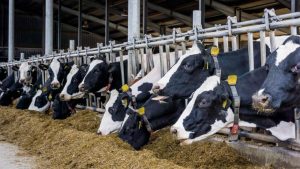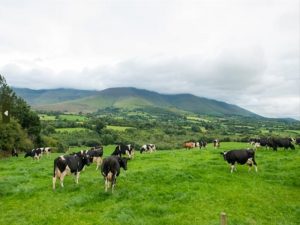
Donald Scully gazes at his herd of 208 cows munching grass and clover in a verdant field, as a light breeze ruffles the stillness.
“There is an enjoyment for me to come out and look and see how healthy and happy these cows are,” says Scully, 47, a third-generation dairy farmer. “Every single cow has her own personality, they’re all individuals.”
The pastoral scene in Ballyheyland, a landscape of rolling hills in County Laois, is replicated across rural Ireland. Ireland has 7.3 million cattle, substantially outnumbering humans, and a long history with the animal stretching into myth, including the Cattle Raid of Cooley, an epic tale considered the Irish Iliad. Agriculture dominated the economy well into the 20th century and moulded a vision of Ireland that still enchants visitors.
Cows, however, now symbolise something else: a climate crisis quandary.
Instead of cutting emissions, Ireland has continued increasing them and the biggest contributor is agriculture. Ireland’s 135,000 farms produce 37.5% of national emissions, the highest proportion in the European Union, and most of that comes from methane associated with belching by ruminant animals.
Under a new government plan, agriculture must reduce emissions by 25% by 2030. Other sectors face even higher targets – transport must reduce emissions by 50%, commercial and public buildings by 40% – but the loudest protests have come from farmers.
Cutting emissions by a quarter will drive many farms into bankruptcy and could force the culling of hundreds of thousands of cows, they say. “The mood is hugely frustrated,” said Pat McCormack, head of the Irish Creamery Milk Suppliers Association. “It’s very hard to quantify but there will be increased costs and reduced output.”
Farmers and their allies have accused the coalition government, which includes the Green party, of scapegoating rural Ireland and leaving farmers little option but to cull herds. So far there have been no Dutch-style protests.
Until recently, the government had encouraged dairy farmers to expand to exploit the end of EU milk quotas. Farmers invested in new equipment and the dairy herd grew by almost half in the past decade. Irish butter, cheese and other produce – 90% is exported – filled supermarket shelves around the world.
“All the talk was of what dairy could deliver for the economy and society and we did that in spades. Now it’s the bad boy,” said McCormack.
In Ballyheyland, Scully, who owns 60 hectares (150 acres) of land and rents another 60 hectares in the shadow of the Cullenagh mountain, not only multiplied his herd five-fold, he made it pedigree Holstein Friesian. His cows roam the fields and subsist mainly on grass, a key selling point that distinguishes Irish produce from other countries that house cows in concrete sheds.
The work is 24/7, Scully says. “You have to love it otherwise you wouldn’t do it.” He hopes his teenage son will become the fourth generation Scully to raise cows but says climate targets could imperil the farm’s future.
“It’s all happening so quickly, and they’re looking for results so fast. Sometimes you would be better moving slow and doing it right.” A way of life, he says, is at stake. “You don’t miss anything until it’s gone.”
Farmers hope that proposed changes in calculating methane emissions, greater efficiencies, new technologies, and other measures could avert the need to reduce herds.
John Sweeney, a climate expert at Maynooth University, is sceptical. “Various tried and untried methods have been advanced to suggest compliance with the 25% emissions ceiling.” They were insufficient, he said. “Only a reduction in numbers can achieve the targets in the short term.”
Sweeney estimates Ireland will need to reduce its number of cattle by 1 million by 2030. “The use of emotive words like ‘cull’ is unhelpful and inflames a process which can be managed in a more gradual manner,” he said.
Farmers were getting off lightly compared with other sectors, said Sweeney. “Agriculture has received a very generous emission ceiling, largely due to the powerful lobby groups it possesses.” The rest of society faces a 60% reduction in emissions to soak up the slack from agriculture.
It remains unclear how – or whether – Ireland will achieve these cuts. It has a record of setting bold and supposedly binding targets, followed by inaction.
John Connell, a farmer and author from County Longford, said that cannot happen again. He wrote a No 1 bestseller in 2018 called The Cow Book, a chronicle of a calving season and a meditation on rural Ireland. His next books will be about the environment.
“Climate is the issue of our time. We all need to pull together now to make sure there is a world for our children and grandchildren to inherit.” Everyone needed to adapt, said Connell. “It’s not going to be easy but we have to think about the global home that we live in. We have to find a way to be gentler with the land.”





